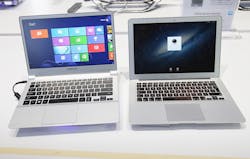Schneider Electric breaks down the equipment behind the Industrial Internet of Things and offers five practical steps for successful implementation. After a year lurking at the edges of 3D printing and wearable technologies, of sensors and robotics, it seems that the Internet of Things has finally climbed to the top of the hot tech hype cycle. It is, as the headlines constantly remind us, the latest, greatest technological revolution and it is out to disrupt the world.
Just watching the predictions around the IoT movement develop, it’s easy to understand the enthusiasm. MGI Research, for example, estimates that in the next 10 years, the total economic impact of the Internet of Things could be somewhere around $11 trillion—that will be about 11% of the world economy at that point.
Meanwhile, research from IDC suggests that today there are about 4,800 new “things” being connected online every minute—a rate that is expected to accelerate to nearly 8,000 per minute by 2020.
The world, it seems, is finally waking up to the realization that linking objects and machines together and making sense of the data they create can yield some amazing (and profitable) results.
For the consumer side of the world, this is novel, exciting news.
But for the manufacturing industry, this is hardly surprising. On this side, this whole “revolution” is just part of a long, slow digital evolution.
“The Internet of Things is 20 years old inside the industry,” says Brian Ballard, CEO and co-founder of Virginia-based software provider, APX Labs. “[IoT] is already very well established here.”
Industrial IoT
Over the years, this decades-long movement has gone by many different names: the Data Highway, M2M, the Industrial Internet, Industrie 4.0, and the Industrial Internet of Things, just to name a few.
For industrial equipment and technology powerhouse, Schneider Electric, however, began way back in 1990 with something called the Transparent Factory.
“It was an idea that was a little bit ahead of its time,” explains John Boville, market segment manager, Process Automation, at Schneider.
“Basically, we just put web service on our PLCs,” he says. “In fact, we were one of the first manufacturers to do so.”
That move, he says, created one of the first systems that tapped the Internet to provide real and valuable insights into the workings of the factory floor.
The technology was indeed ahead of its time. It was not, however, the kind of connected systems we have at our disposal today.
“All of this early stuff was limited; all of it was proprietary,” Boville explains. “That’s not big data, that’s not a transparent factory, and that is certainly not the Internet of Things.”
What it was, he argues, is just a series of proprietary networks working in isolation.
But today things are different.
Seeds of Change
Looking back at the predictions for a moment, we can find some very strange trends emerging.
According to a recent report by Deloitte, about 60% of all wireless IoT devices will be bought, paid for, and used by enterprises and industries over the next few years. Furthermore, it predicts that 90% of all services revenue generated by IoT will be enterprise, not consumer.
That is a curious finding. If the consumer world is just waking up to sensors and big data and the industry world has had it for so long, why is there suddenly such a buying frenzy occurring in industry?
The answer, it seems, is all about industrial Ethernet.
IE’s open architecture protocols allow manufacturers for the first time to connect all of the devices and equipment—machine tools and hand tools, PLCs and motor starters—to a common data stream, regardless of what name brand any particular device bears.
That has, Boville says, completely changed the game.
He points to products like his company’s Modicon M580 ePAC—built with native Ethernet and embedded cybersecurity at its core. The device, Schneider Electric boasts, is the first of its kind to be specifically designed of the Industrial Internet of Things.
“You can literally connect all of your devices on these,” Boville explains. “You can get access to all of that data and bring it up and use it.”
And that’s not just the plant floor data, he adds. A full system can link building management systems, energy management systems, raw material consumption, and real-time productivity info.
“Suddenly,” he explains, “rather than just wandering around like you would in the old days with a clipboard and pen, you can actually scientifically chase productivity bottlenecks and be able to address them wherever they are in operation.”
Again, this is the same basic theory the industry has been following for decades. But with the new technologies, Boville explains, “today it is much, much simpler.”
A Simple, Five-Step Plan
With so much potential here and so many technologies targeting the market suddenly, it can be difficult to know where to start—much less how to implement these new “simpler” solutions.
To help, Boville offers a five-step process to harness the full potential of the Industrial Internet of Things:
1. Develop a plan
Start with assessments—figure out where you are, where you want to be, and how you are going to get there. Don’t forget to factor in scheduled downtime as you upgrade your system.
2. Modernize
There’s no way around it, you’re going to have to upgrade.
On the hardware side, a good IoT system includes PLCs and motor starters equipped with Ethernet, then switches and bridges. Then there is software—the data mining and analytics systems from which you will eventually derive the real value.
The good news is that this doesn’t have to happen all at once. IoT systems can be built in a staged retrofit, upgraded top-level processors first and then tackling the I/O at some point in the future.
3. Find a partner
With all of the reductions in workforces in plants today, it’s not likely that you have too many people sitting around waiting to do controls management projects. So it is a good idea to either partner with an IIoT equipment provider or with a trusted systems integrator to help with the upgrade—someone who knows the process and what the two points are in the journey.
4. Consider your cyber risks
Because you’re getting into an internet situation in this journey, you’re going to have to start thinking about cyber security. You will need to assess your risks, install a system that protects against them, and continue monitoring things going forward.
5. Think big
Remember, you don’t just go out and buy the Internet of Things. It’s data—a lot of data. You have to have a strategy to analyze that data and turn it into usable business intelligence. While hardware and software are important components, it’s much more than just that.
Following these steps before jumping into any large IoT project, Boville says, will make the project much easier. In the process, he says, manufacturers should find they have a lot to gain.
“You have at your fingertips the data necessary to truly understand how your facility is running,” he says. You can look at production downtime and bottlenecks; unlock typically 10% improvement in uptime and productivity.”
“Basically,” he adds, “you’re throwing away the clipboard and the stopwatch and starting to do data-driven process improvement.”
About the Author
Travis Hessman
VP of Content, Endeavor Business Media
Travis Hessman is the VP of Content for Endeavor Business Media. Previously, Travis was the Editor-in-Chief for Industry Week and New Equipment Digest as well as the Group Editorial Director for Endeavor's Manufacturing Group.
He began his career as an intern at IndustryWeek in 2001 and later served as IW's technology and innovation editor. Today, he combines his experience as an educator, a writer, and a journalist to help address some of the most significant challenges in the manufacturing industry, with a particular focus on leadership, training, and the technologies of smart manufacturing.

